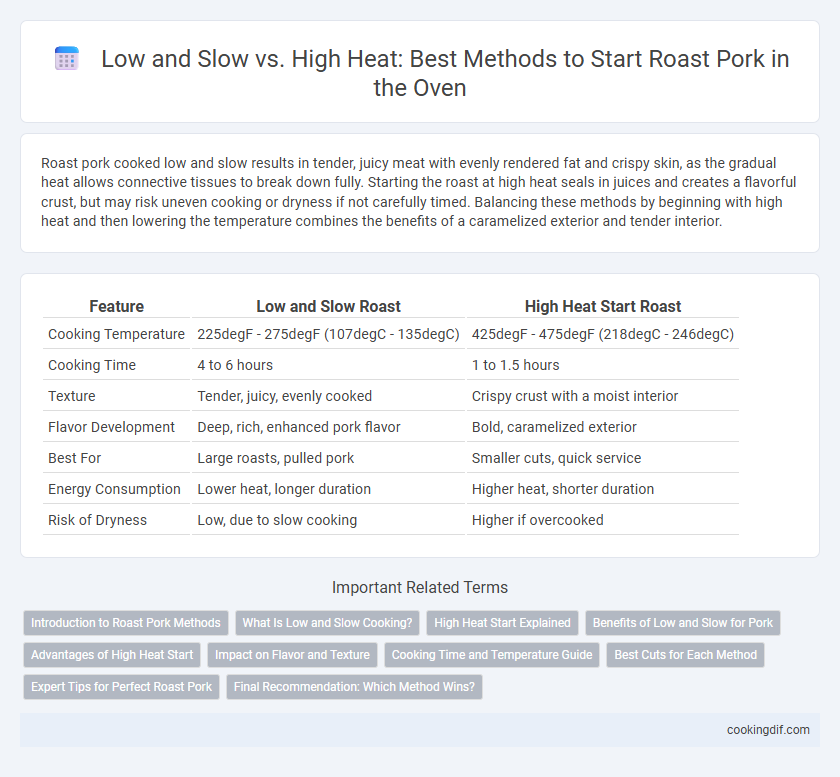Roast pork cooked low and slow results in tender, juicy meat with evenly rendered fat and crispy skin, as the gradual heat allows connective tissues to break down fully. Starting the roast at high heat seals in juices and creates a flavorful crust, but may risk uneven cooking or dryness if not carefully timed. Balancing these methods by beginning with high heat and then lowering the temperature combines the benefits of a caramelized exterior and tender interior.
Table of Comparison
| Feature | Low and Slow Roast | High Heat Start Roast |
|---|---|---|
| Cooking Temperature | 225degF - 275degF (107degC - 135degC) | 425degF - 475degF (218degC - 246degC) |
| Cooking Time | 4 to 6 hours | 1 to 1.5 hours |
| Texture | Tender, juicy, evenly cooked | Crispy crust with a moist interior |
| Flavor Development | Deep, rich, enhanced pork flavor | Bold, caramelized exterior |
| Best For | Large roasts, pulled pork | Smaller cuts, quick service |
| Energy Consumption | Lower heat, longer duration | Higher heat, shorter duration |
| Risk of Dryness | Low, due to slow cooking | Higher if overcooked |
Introduction to Roast Pork Methods
Roast pork cooking methods significantly impact texture and flavor, with low and slow or high heat start approaches shaping the final outcome. Low and slow roasting at temperatures around 250-300degF ensures tender, juicy meat by gradually rendering fat and collagen. In contrast, starting with high heat at 425-450degF sears the exterior, creating a crispy crust while locking in juices before lowering the temperature for thorough cooking.
What Is Low and Slow Cooking?
Low and slow cooking involves roasting pork at a low temperature, typically between 225degF and 275degF, for an extended period to ensure tender, juicy meat with enhanced flavor development. This method allows connective tissues to break down gradually, resulting in a moist and succulent roast that is evenly cooked throughout. Low and slow cooking is ideal for tougher cuts, which become fork-tender without drying out or toughening the exterior.
High Heat Start Explained
Starting roast pork with a high heat method sears the exterior, locking in juices and creating a flavorful crust. This technique enhances Maillard reaction, resulting in a rich, caramelized surface that intensifies the overall taste. High heat start reduces cooking time while maintaining tender, juicy meat inside.
Benefits of Low and Slow for Pork
Roasting pork low and slow at temperatures between 225degF and 275degF ensures even cooking, preserving moisture and resulting in tender, juicy meat. This method breaks down connective tissues gradually, enhancing flavor and creating a succulent texture that high heat often cannot achieve. Slow roasting also minimizes the risk of overcooking, producing consistently flavorful and melt-in-your-mouth pork.
Advantages of High Heat Start
Starting roast pork at high heat sears the meat, locking in juices and creating a flavorful, caramelized crust that enhances texture. This method reduces overall cooking time while maintaining tenderness and moisture in the pork. High heat initiation also promotes Maillard reactions more effectively, resulting in a richer, deeper flavor profile compared to low and slow roasting.
Impact on Flavor and Texture
Roasting pork low and slow at temperatures around 250-300degF enhances tenderness by breaking down collagen and rendering fat evenly, resulting in juicy, flavorful meat with a melt-in-the-mouth texture. High heat starts, typically above 425degF, create a crisp, caramelized crust through Maillard reactions but risk drying out the interior if not carefully managed. Balancing heat application is critical to achieving a roast pork that combines a savory, well-browned exterior with moist, tender interior texture.
Cooking Time and Temperature Guide
Roast pork achieves optimal tenderness and juiciness when cooked low and slow at 225-275degF for 3-5 hours, allowing the connective tissues to fully break down. High heat starts around 425degF for 20-30 minutes create a crispy crust but require lowering to 325-350degF to finish cooking evenly without drying out. Monitoring internal temperature to reach 145degF ensures safe consumption while balancing texture and flavor.
Best Cuts for Each Method
Pork shoulder and pork butt are ideal for low and slow roasting due to their higher fat content and connective tissue, which break down over time to create tender, flavorful meat. In contrast, pork loin and tenderloin suit high heat roasting as their leaner profiles benefit from quick cooking to retain juiciness and avoid drying out. Choosing the right cut based on the heat method enhances texture and flavor for the perfect roast pork experience.
Expert Tips for Perfect Roast Pork
Expert chefs recommend starting roast pork low and slow at 250degF to 275degF for tender, juicy meat while rendering fat evenly. For a crispier crust, some suggest searing at high heat (450degF) initially, then lowering the temperature to ensure even cooking without drying the pork. Using a meat thermometer to reach an internal temperature of 145degF guarantees safe, succulent results when following either method.
Final Recommendation: Which Method Wins?
Roast pork achieves optimal tenderness and juiciness when cooked using the low and slow method, which ensures even heat penetration and fat rendering for a moist interior. High heat starts can create a crispy crust but risk uneven cooking and dryness due to rapid moisture loss. For the best overall flavor and texture, the low and slow technique is the preferred cooking approach.
Low and Slow vs High Heat Start for Roast Pork Infographic

 cookingdif.com
cookingdif.com